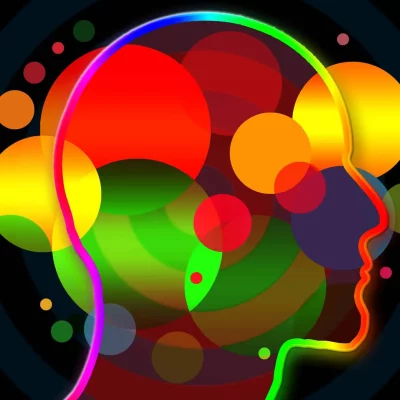What is Abnormal Psychology?
Abnormal psychology is a subdivision of psychology that deals with “abnormal” behavior or behaviors that don’t follow the norm. It is easier to visualize what we mean by this when we look at a bell curve. The height of the bell curve is the normal behavior. If we were looking at stress levels, for instance, then the stress levels held by most people define the normal behavior. This represents the peak of the bell curve. The outliers, people with higher levels of stress, are those with abnormal behavior. Abnormal behavior doesn’t always have a negative association, as outliers in this example could also be people with an abnormally low amount of stress.
Characteristics of Abnormal Psychology
When considering if a certain behavior is abnormal or not, there are four characteristics that should be considered. Deviance, dysfunction, distress, and danger are all factors that are important to take into account. The bell curve example above illustrates the deviance criteria. This means evaluating how an individual’s behavior relates to the standard behavior of the population. Dysfunction refers to how the behavior interferes with the individual’s life. If someone had an anxiety disorder that prohibited them from being able to go out in public places, then the disorder was interrupting the daily functioning of the individual’s life.
High levels of fear, anxiety, depression or the emotions can be used to measure a level of distress. Phobias can demonstrate distress. An individual who has a phobia of snakes would feel distress while walking in the woods or other areas that snakes usually reside. Danger is the last criteria. Being a danger to yourself or others defines this category. An example of this could be an individual with a substance disorder. A substance disorder not only brings danger to the individual that is abusing a harmful substance but also is a danger to those around him. It can be hard to control one’s actions when under the influence. Abusing a substance can put friends and family of the abuser in harms way.
Common Diagnoses
Many disorders, ranging from depression and anxiety to schizophrenia, fall under the category of Abnormal Psychology. These diagnoses are widespread, with the Anxiety and Depression Association of America (ADAA) reporting that anxiety disorders affect about 18.1% of the US population every year. This may sound like a small percentage, but 18.1% translates to around 42 million adults. On the other hand, Abnormal Psychology also covers the less diagnosed disorders. The National Institute of Mental Health reports that schizophrenia has a prevalence rate between 0.25% and 0.64% in the United States. The most common disorders are depressive and anxiety disorders.
Depressive Disorders
Depressive disorders include major depressive disorder, postpartum depression, and seasonal affective disorder.
One of the disorders, major depressive disorder, is feeling depressed or sad for an extended period of time while experiencing symptoms of hopelessness or loss of pleasure in previously exciting things. Symptoms can also affect an individual somatically through the loss or gain of weight, decreased energy, or headaches/pains that don’t have a clear source. Depression changes a person’s attitude and can make them more irritable or restless. This disorder affects around 16 million American adults a year, making it one of the more common disorders. Risk factors for depression include having a family history of depression, going through a traumatic or stressful time, or even some physical illnesses and medication. Every individual is different, so depression can manifest in a wide range of symptoms that can make each person’s experience with depression different.
Another widespread depressive disorder, seasonal affective disorder, occurs typically during the winter months when there is less sunlight. Symptoms of this disorder include social withdrawal, weight gain, and increased sleep. This disorder is temporary in the fact that the depression usually decreases during the spring and summer months when the amount of daylight increases.
Anxiety Disorders
Anxiety disorders affect more people in American than any other mental disorder and include generalized anxiety disorder, social anxiety disorder, panic disorder, and phobias. Generalized anxiety disorder (GAD), to elaborate on one specific disorder, is intense worry and anxiety that does not have a specific source and occurs over an extended period of time. These negative thoughts are usually accompanied by trembling or shaking, trouble sleeping, muscle tension, or headaches.
GAD generally occurs during childhood or adolescence and builds up gradually. However, it is possible for GAD to come on during adulthood. GAD is associated with fear of future events and anticipating the worst. Individuals with GAD tend to get stuck in thought loops which occur when a person is unable to stop ruminating about a negative thought and the thought continues to be repeated. The individual usually realizes that whatever unpleasant thought they are catastrophizing is irrational, however they do not have the ability to shake their concerns. Many of the anxiety disorders share symptoms, panic attacks and excessive worry being some common symptoms. GAD is different from other anxiety disorders in the fact that it is usually less interruptive in people’s day to day lives. People with GAD tend to be less likely than people with other anxiety disorders to avoid certain situations because of their disorder.
Treatments
Cognitive Behavioral Therapy
Various forms of psychotherapy can treat these diagnoses. Cognitive behavioral therapy (CBT) is an effective type of therapy that helps depression, anxiety, and other disorders. The therapy aims at making the patient aware of their negative thoughts and looking at them from an objective, rational point of view. CBT typically occurs in four different steps. It begins with identifying the troubling parts of your life, whether it be specific anxieties involving school or problems dealing with social relationships. Then, the patient takes notice of these negative thoughts when they occur and can either share their thoughts with their therapist or write them down in a journal. From there, the therapist asks the patient to pay attention to their reaction to these thoughts. The goal is to recognize that the thoughts are negative and irrational. The final step of CBT is to take these unpleasant or inaccurate thoughts and correct them.
If a patient was struggling with anxiety about a presentation in class, they could think that if they mess up then the whole class will laugh at them or the teacher will automatically fail them. CBT would have the patient identify that this an irrational thought and then think about how the situation would go realistically. For instance, most students don’t pay that much attention to presentations and will most likely not remember the presentation come the end of the day. Teachers will probably not fail a student for a mistake in a presentation, and even if, the class can always be taken again. CBT is an effective therapy that some pair with medications like antidepressants or anti-psychotics.
How Can We Help?
If you are experiencing any of these symptoms it is important to get help. With the proper mental health advice, the overwhelming feelings of anxiety and depression can be treated and we can help you get your health on track. We can provide mental health counseling for anxiety and depression right here in our office. Please contact our office at (412)-532-1249 to schedule according to your availability and preferred location
About Makin Wellness
Founded in 2017 , Makin Wellness is Pittsburgh’s premier therapy & coaching centers located in Downtown Pittsburgh and Downtown New Kensington. The company’s mission is to help people heal and become happy again. Makin Wellness specializes in depression, anxiety, addiction, trauma, medical marijuana assisted treatment and relationship counseling.

Founder of Makin Wellness







